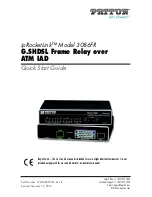
24-port NWay Ethernet Switch User’s Guide
4
Introduction
a traditional router would have one or two high-speed serial
WAN connections, the DES-3326 relies upon a Fast Ethernet
port to connect to a separate device, which in turn, connects the
network to a WAN or the Internet.
The DES-3326 can be thought of as 24 Fast Ethernet Layer 2
switching domains with a wire-speed router between each domain.
It can be deployed in a network between a traditional router and
the intranetwork. The traditional router and its associated WAN
interface would then handle routing between the intranetwork
and the WAN (the Internet, for example) while the Layer 3
switch would handle routing within the LAN (between the Fast
Ethernet Layer 2 domains). Any installed Layer 2 switches, and
indeed the entire subnetting scheme, would remain in place.
The DES-3326 can also replace key traditional routers for data
centers and server farms, routing between these locations and
the rest of the network, and providing 24 ports of Layer 2
switching performance combined with wire-speed routing.
Backbone routers can also be replaced with DES-3326 and a
series of DES-3326 could be linked via the optional Gigabit
Ethernet ports. Routers that service WAN connections would
remain in place, but would now be removed from the backbone
and connected to the DES-3326 via an Ethernet/Fast Ethernet
port. The backbone itself could be migrated to Gigabit Ethernet,
or faster technologies as they become available.
Policy services can then be introduced (or enhanced) in the
backbone infrastructure and maintained throughout the
network – even to the desktop. With a distributed infrastructure
and a logical management structure, network performance
becomes easier to measure and fine-tune.
With the completion of the migration of the backbone to Gigabit
or higher-performance technologies, the result is inherently
scalable and easily evolved for future technologies. This core
















































